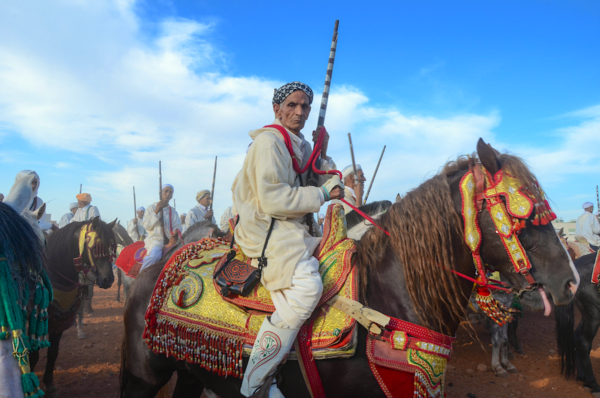After several years of advocacy from Moroccan representatives, UNESCO officially inscribed tbourida, a North African cavalry performance, on their Representative List of the Intangible Cultural Heritage of Humanity in 2021. Let’s take a look at the history and modern presence of this equestrian art.
What is Tbourida?
Tbourida, also known internationally as fantasia, is an equestrian art form prominent in Morocco and other North African countries. The word tbourida is derived from baroud, which means gunpowder in Arabic. Tbourida is performed by troupes called sorbas, which are made up of 15 to 25 riders and horses. The riders typically wear traditional djellabas representative of their tribe and geographic region, and carry a sword and a copy of the Quran. Both Arabian and Barb horses compete in tbourida.
During the performance, each troupe is led by a mokkadem, who sets the pace of the gallop and coordinates their movements. The show is divided into two parts. First is the hadda, during which riders begin the race at a trot and give an acrobatic salute. Second comes the talqa, where the horses quickly gallop down a straight racetrack, and riders fire a round of gunshots into the air to simulate the beginning of a war.
The most challenging aspect of the performance is said to be synchronizing the movements of all of the horses and firing the shot into the air simultaneously.
History of Tbourida
The practice of tbourida originates from the ancient kingdom of Numidia and the cavalry of King Massinissa. Some historians also believe that the performance drew from Eastern Libyan practices of using bearded horses to tow tanks. Over time, tbourida has evolved with the influence of Arab and Amazigh culture, producing many regional variations across North Africa. The form of tbourida seen today is said to have emerged in the fifteenth or sixteenth century.
In 1832, French painter Eugene Delacroix witnessed tbourida performances during his travels to Morocco and Algeria. He was inspired to create several orientalist depictions of tbourida, including his 1833 painting Fantasia arabe. These pieces sparked interest in tbourida among the European audience and popularized the term fantasia.
Tbourida in Morocco
The Moroccan government has taken an active role in the preservation and promotion of tbourida. In 2003, the Ministry of Agriculture and Fisheries created SOREC, an organization dedicated to the advancement of tbourida. Currently, around 1,000 troupes are registered with SOREC. After an intense qualification process, around 330 of them compete during the Week of the Horse competition to win the Hassan II National Tbourida Trophy. The Week of the Horse events take place in El Jadida around October of each year. Outside of this, tbourida is often performed at cultural events, weddings, and moussem festivals — large annual gatherings featuring music and cultural celebration, often dedicated to a concept like roses or betrothals.
While tbourida is traditionally performed by men, several all-female troupes have emerged in Morocco, particularly near Casablanca. Female riders often describe learning tbourida from their fathers and grandfathers to carry on their family traditions. While some critics say that tbourida is meant to symbolize a special masculine relationship between riders, horses, and warfare, female tbourida troupes have gained increasing acceptance over time. In 2004, Casablanca’s annual Fantasia festival began permitting female troupes to compete, coinciding with a broader feminist sentiment that arose after Morocco’s personal status and family code was amended to secure several landmark rights for women.
Regional Variations
While tbourida is most common in Morocco and Algeria today, it is also performed in Libya, Mali, Mauritania, Niger, and Tunisia. Regional variations of tbourida invoke the unique traditions of each country.
Algerian tbourida is notably performed at the Sidi Yahia Bensafia d’Ouled N’hare and Sidi Ahmed Almadjoub festivals. It differs from its Morrocan counterpart in that only nine or 11 riders typically participate. Additionally, there are two different categories of Algerian tbourida: the temerad and the guelba. Both variations are similar, but the temerad involves a collective group start while guelba riders begin halfway down the course and make a U-turn at their own pace. Any riders that fall behind must rapidly catch up to the group.
Eastern Algeria is also home to a unique form of fantasia involving only one to three riders who simulate an attack and hold onto each other boot to boot, creating the illusion of a single rider during their performance.


